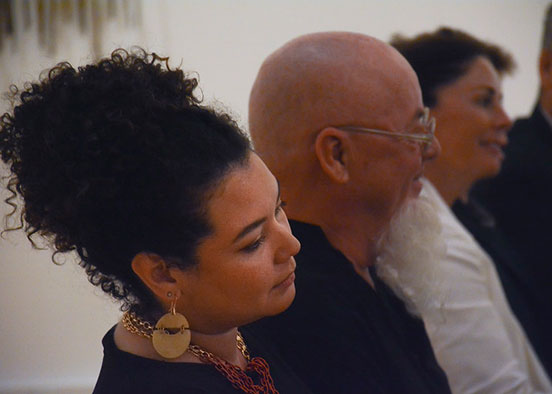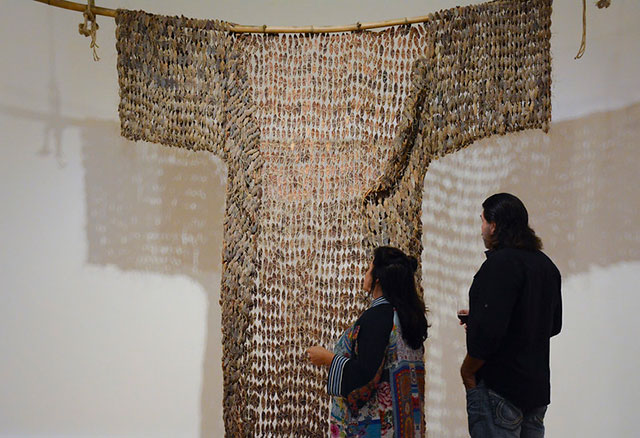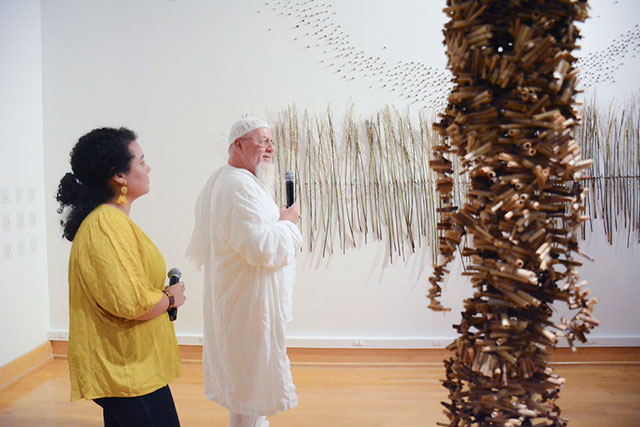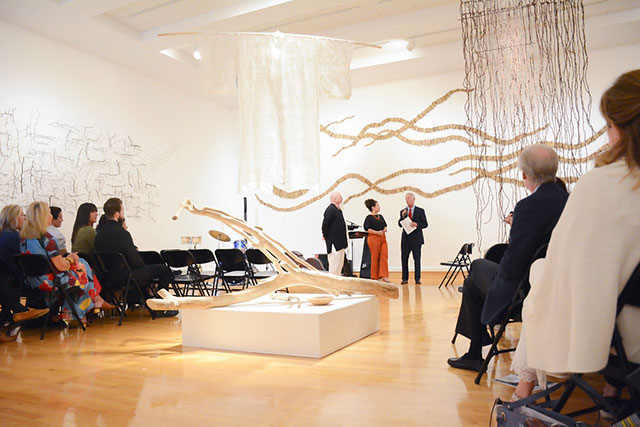At the opening reception of “Presence: Ran Adler” at FGCU’s Wasmer Art Gallery at the end of January, gallery assistant Marcela Pulgarin was explaining the process of having sewn together hundreds of mahogany pods for the enormous “Kimono” piece hanging from a large bamboo culm.
She grabbed the sleeve to open the kimono and show the stitching, and her companion gasped audibly.

“My blood and sweat is in this room,” Pulgarin said, laughing at the idea that she wasn’t allowed to touch the museum gallery piece.
“We’ve had FGCU students assist a number of artists in the past preparing exhibitions, but this has been the most in-depth role an FGCU gallery assistant has taken on assisting an artist,” said Art Gallery Director John Loscuito.
“When we started talking about the exhibition with Ran, it was clear that the scale of the artworks he was proposing would require some additional help to make them,” Loscuito added. “Since most of the pieces would be new, the sheer labor in processing the materials alone was daunting.”
Pulgarin had worked on other exhibitions in the Wasmer gallery, and Loscuito knew she was passionate and dedicated to the process of preparing an exhibition.
“Ran Adler has been a prominent artist in Naples for some time, consistently making beautiful and thoughtful work,” Loscuito said about how Adler was chosen as a guest artist exhibiting at the Wasmer gallery, where his work will be on display through Feb. 27. “I was curious to see his work in a larger space as a solo installation, and was confident that it would present new materials and ideas to our students and community.”
“I’ve apprenticed in several ways in my creative life, and I think that’s how Marcela was looking at things, too,” Adler said. “The university is very generous and it’s a great honor to have this show, but also to have Marcela work side by side with me.”
Immigrant artists face challenges
Twelve years ago, Pulgarin emigrated from Colombia at 18. A first-generation college student, she’s working toward her bachelor’s degree in art. In addition to assisting Adler with this current exhibit, Pulgarin has helped with the installation for all guest artists since she started working at the gallery in the spring of 2019. In fall 2019, that included the first survey exhibition of Mexican artist Enrique Chagoya’s work in Florida for “Everyone is an Alienígeno.”

“I came here at 18 and I’ll always be Colombian, but I’m a U.S. citizen, and I’m interested in how other immigrant artists face that dilemma and remain authentic,” Pulgarin said.
Working on “Presence: Ran Adler,” Pulgarin described Adler as calm and organized, and his studio as a very peaceful, soothing environment. “We couldn’t have rushed through what we were doing in a place like that,” she said. “And his work demands that. That environment he’s created engages your senses, so when we were working with the sea grapes, I was more aware of their fresh smell and how they dyed my fingers.”
Loscuito added, “Adler commented to me early on that his method of working requires space to think without stress and anxiety, and I was pleased that Pulgarin also adopted this and maintained that spirit throughout the whole process. Every step of the way, the both of them became more excited about the possibilities, so it seemed like a great fit.”
“On the kimono, that was hours and hours of sitting across from each other and tying,” Adler said. “Some of the work is very meditative, but she was also there to learn, so we talked a lot.”
Pulgarin was grateful that Adler was willing to answer any questions she had through the process. “I know I grew as an artist because I saw his process and how he was coming up with solutions,” she said.
Seeing the business side of art
In addition to working as a gallery assistant at the Wasmer gallery, Pulgarin conducts art workshops at Vino’s Picasso and has a job at a copy shop. Her ultimate goal would be to make a living from art. “I want to crash and burn and fail at art before I take any other job,” Pulgarin said. “We romanticize art, but it is still a business.”
“That lesson rose up organically out of her curiosity,” Adler said. “We worked in the studio downtown where much of my art is, and it’s very public. There was business being down there, and it was an environment unfamiliar to her. She adjusted immediately.”

Past collaborations of gallery assistants and artists have allowed students to learn about the business of being an artist, including selling work, networking and speaking about their artwork. Pulgarin noted that Adler was willing to share advice from his own journey as a successful artist, and answered questions she had about pricing and marketing. In Adler’s studio, Pulgarin was able to network with his clients and other artists.
“We hoped that Marcela would learn all of these things, but also be engaged in the creative process and preparing the artwork itself. It was an opportunity for a student to really learn an artist’s studio practice by going to the studio every week and having a hands-on experience in every step of making the artwork,” Loscuito said.
“The pieces are big and stunning,” Pulgarin said, “but the process is to me the impressive part.”
Pulgarin would advise every student to participate in an internship. “You don’t get these experiences without working with someone doing what you want to do.”
Adler would agree with that advice. “I’ve always found someone I wanted to learn from, and I’d work with them for next to nothing just to learn,” he said. “There was mutual respect there, and I felt a loss when the term was over. I was so used to having her.”
Students travel to view the best
In 2018, Pulgarin and a group of FGCU students went to Art Basel in Miami, courtesy of a grant from the Seidler Fund. In summer 2019, Pulgarin was also one of nine FGCU students to attend a grant-funded trip to New York City to visit museums, including the Guggenheim, the Metropolitan Museum of Art, the Whitney Museum of American Art, and the Shed at Hudson Yards, which opened in April 2019.
“When we make art, we have something to say that is so overwhelming that we have to put it in 2D or 3D,” Pulgarin said. She added that she’s inspired by other artists, her classmates, moods and states of mind.
Her favorite works on the FGCU campus include the Romero Britto piece in front of the gallery and the Sanctuary sculptures, which are slightly hidden among the nature trails throughout campus. The gallery assistants are responsible for periodically cleaning the public art on campus, so Pulgarin has had her hands on these pieces as well as the Adler creations.
Suspended from the ceiling on a bamboo culm acting as a large clothes hanger, Adler’s “Kimono” swayed slightly after Pulgarin opened it to show off the hemp stitching at the opening reception of the show. She explained to her companion that the culm was from the FGCU Food Forest and the mahogany pods were all sourced locally. As they moved toward “It’s All Prayer,” where Pulgarin was explaining that working with the sea grapes had dyed her fingers for several days, another woman approached “Kimono” and tentatively stroked the mahogany pods before glancing around mischievously.
“Art that has an idea behind it moves me to create,” Pulgarin said, as “Kimono” swung gently from the ceiling.
